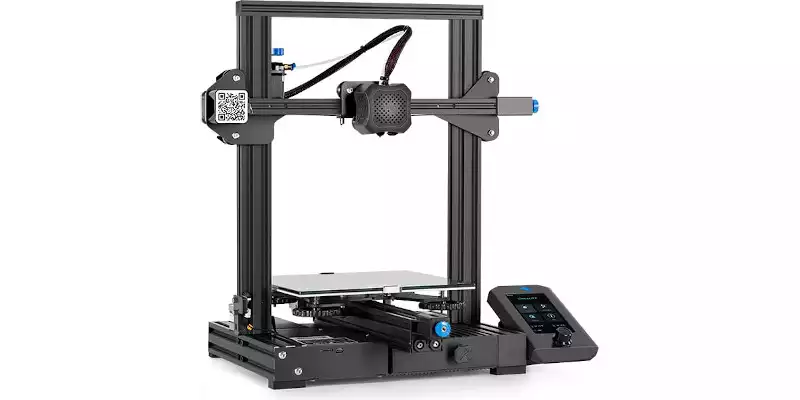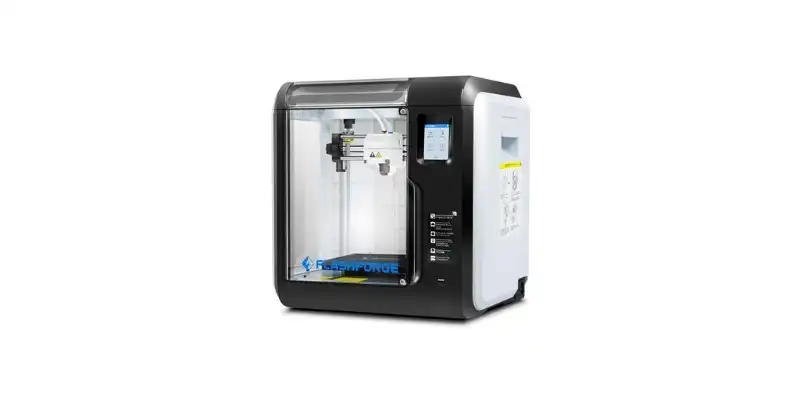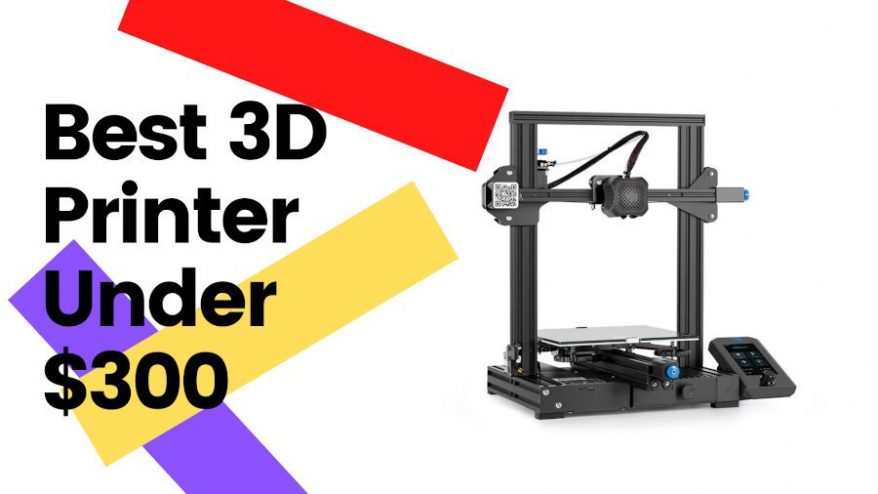
We’re not quite at a stage where 3D printers are in every home like computers or smartphones, but you can now get a great 3D printer for under $300. With so many options out there, we’ve narrowed it down to our top $300 3D printers. But first, here’s what you can expect from a 3D printer under $300.
| Name | Price | Where to buy | |
|---|---|---|---|
| Creality Ender 3 V2 | $249 | Creality Store here | Amazon here |
| Qidi Tech X-one2 | $249 | Amazon here | |
| Anycubic Photon Mono 4K | $299 | Anycubic Store here | Amazon here |
| Geeetech A10M | Check | Amazon here | |
| Anycubic Mega S | $249 | Anycubic Store here | Amazon here |
| Flashforge Adventurer 3 Lite | $299 | Amazon here |
What to expect in a 3D printer under $300
Naturally, you can’t expect the world for $300. More premium printers will offer better precision, stability, consistency, a wider material range, and better temperature control.
|
|
|
|
|
$299
|
$279.99
|
$299
|
|
|
$300 3D printers almost always feature an open print area rather than a built-in enclosure — though some can be fitted with enclosures — are often 3D printer kits you need to build yourself, and are mostly restricted to filaments like ABS, PLA and TPU.
However, there are still some really effective low cost 3D printers for $300 on the market right now, famed for their reliability and workhorse qualities. We’ve listed some of our top recommendations below.
Best 3D Printers Under $300 in 2023 – Reviews
3DSourced is reader-supported. When you buy through links on our site, we may earn an affiliate commission. Learn more
Creality Ender 3 V2 — best 3D printer under $300
- Price: $279 — Available on Creality Official Store here / Available on Amazon here
- Build volume: 220 x 220 x 250 mm
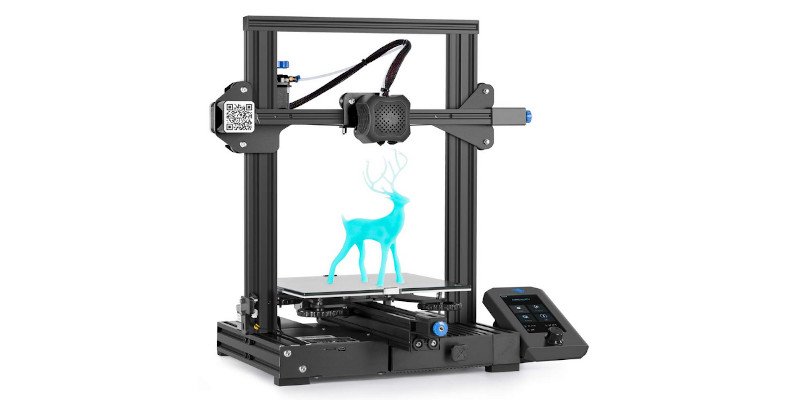
Pros
The most popular 3D printer under $300.
Good build volume, precise printing, reliability, and good upgradability.
Powerful, quiet, and a good 3D printing experience.
Cons
There are more advanced 3D printers with newer features available.
As the world’s current most popular 3D printer under $300, the Ender 3 has really made its mark as an affordable printer suitable for hobbyists and home makers across the world.
Its combination of good build volume size, precise printing, reliability and upgradeability has won it legions of fans worldwide, with Creality upgrading a few parts for the newer Ender 3 V2.
The changes are subtle but make for a steadily improved 3D printer that costs less than $300 still, despite being more than $50 more than the original Ender 3. Perhaps most notably, the firmware has been overhauled for a more powerful, yet quieter, 3D printing experience.
Known for its reliability in a price range where most 3D printers fail prints often and break, the Ender 3 can’t do many things that $500 or $2,000 3D printers can, but what it does do, it does well. It can print basic models in PLA and other simpler filaments effectively, precisely, and consistently.
Other notable features are the carborundum glass build plate that makes finished prints easier to remove once finished, and improves adhesion during the printing process. The 4.3-inch color touchscreen is a nice touch that many will appreciate, and overall, if you want piece of mind and a reliable printing experience in one of the best 3D printers under $300, the Ender 3 V2 is for you.
Anycubic Mega S — reliable 3D printer for $300
- Price: $249 — Available on Amazon here / Available on Anycubic Official Store here
- Build volume: 210 x 210 x 205 mm
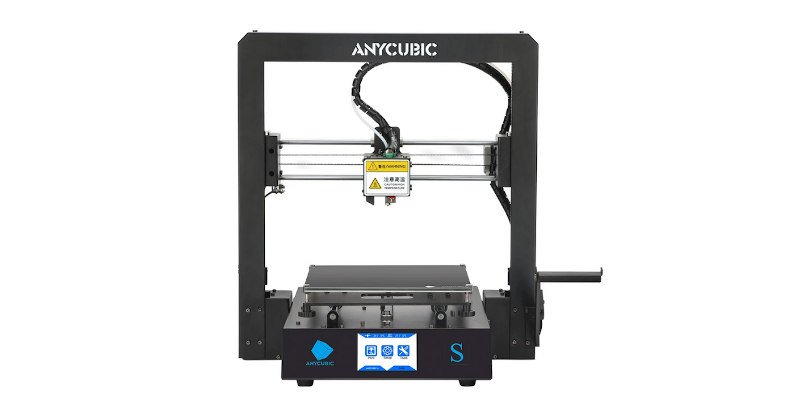
Pros
Easiest 3D printer to build in its price range.
Consistent and reliable.
Sturdy and stable.
Cons
The interface could be a bit better.
Possibly the easiest 3D printer kit to build in its price range, the Anycubic Mega S can be built with just a few screws and cables — even the greenest beginners should have no problem building their own.
This simplicity is key in a 3D printer under $300, with most hobbyists looking for a hassle-free 3D printing experience where their 3D printer doesn’t break down every five minutes, and just prints consistently and reliably. The Mega S is that printer, featuring everything you need to print without hassle — and not much else. Barebones yet reliable, it’s built with a sturdy and stable metal structure to prevent the vibrations from printing causing shaky lines in the print.
The 210 x 210 x 205 mm print volume should be enough for most hobbyist projects, and if you’re a small business looking to get started with rapid prototyping on basic materials like PLA, ABS or TPU, the Mega S should work for smaller parts.
- And if the build volume isn’t enough, upgrade to the Mega X for another $100 — On Amazon Here
All Mega models feature Anycubic’s patented Ultrabase print surface which makes for better adhesion — creating stronger and less error-prone prints — as well as making them easier to remove when finished, so you won’t need to scrape around and potentially damage your print while trying to remove it.
As with most 3D printers under $300, it has a basic touchscreen, offers good precision, and if you want to get more ambitious, you should also be able to 3D print wood filaments, PETG, and HIPS. Overall, it’s a reliable and consistent $300 3D printer.
Anycubic Photon Mono 4K
- Price: Check on Anycubic Official store here / Amazon here
- Build volume: 132 x 80 x 165 mm
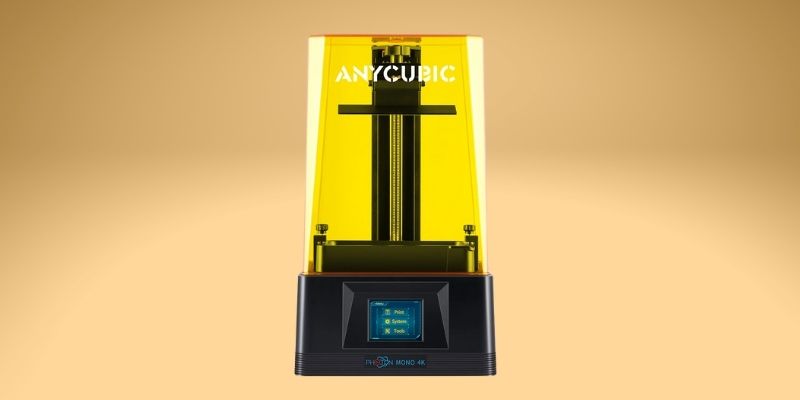
Pros
Focused on delivering where it matters.
4K monochrome LCD.
For the price, the level of detail exceeds what you’d expect.
Cons
By no means a productivity printer.
Despite only launching at the tail end of 2021, the Anycubic Photon Mono 4K is already proving to be a disruptive force in the competitively-priced high-resolution resin printer range. It’s abundantly clear that Anycubic focused on delivering where it matters while cutting costs in areas that don’t impact the printer’s overall performance.
As an iterative upgrade to the popular first-gen Photon Mono, the 4K version comes with several improvements, not least the ability to dabble in 4K printing thanks to a 6.23-inch 4K monochrome LCD and finer 35-micron resolution.
The build volume remains unchanged at 132 x 80 x 165 mm; you can batch print, but this is by no means a productivity printer. While we can’t describe the Anycubic Photon Mono 4K as a speed demon, it holds its own with print speeds of 50 mm/hour, itself a significant improvement over the original Photon Mono.
These specifications make the Anycubic Photon Mono 4K particularly adept at printing modestly-sized detailed miniatures, models, and figurines. The printer should appeal to those partial to sprucing up their weekly Dungeons & Dragons bash with homemade pieces, for example.
For this price, the level of detail exceeds what you’d expect, with a particular proficiency for creating articulated parts and complex textures. Skin pores render well, and details on, say, a shield or the intricate mesh of chain mail are fantastic.
Anycubic’s Photon Workshop slicer does the job well enough, with some sleek features like anti-aliasing. Compatibility with Lychee and ChiTuBox give options if Anycubic’s in-house developed software leaves you cold.
Overall, if you’re looking to take those tentative first steps into resin printing and are in the market for an inexpensive entry-point, the Anycubic Photon Mono 4K is an ideal place to start.
Qidi Tech X-ONE 2
- Price: Check on Amazon here
- Build volume: 145 x 145 x 145 mm
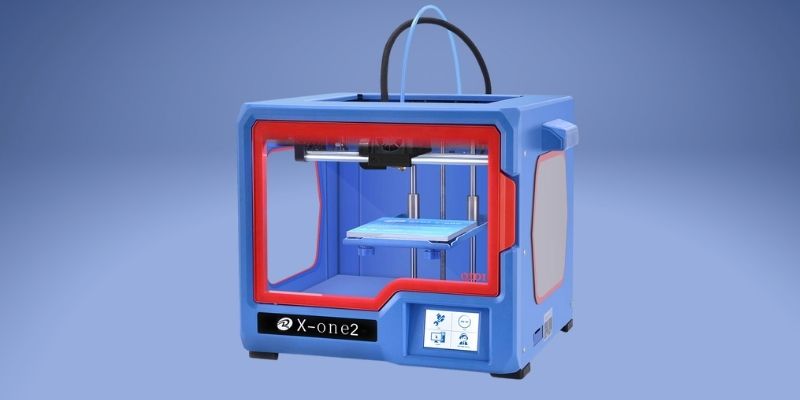
Pros
Impressive features.
Can use TPU, flexible filaments, and PETG with the proper settings.
Versatile and easy to use.
Cons
Tight build volume.
It’s in Qidi Tech’s habit of decking out its wares with features usually found on pricier FDM printers without sacrificing a deadset commitment to affordability that the Qidi Tech X-One2 sets itself apart from the competition.
The Qidi Tech X-One2 impresses with features such as a heated bed, 50-micron layer height, direct-drive single extruder, resume function, and a parameter-rich 3.5-inch touch screen interface. For us, the near fully enclosed chamber rises to the surface as the star of the show, bestowing the Qidi Tech X-One2 with just the right, toasty environment to steward temperature-sensitive ABS filament into decent prints.
Pop open the acrylic covers, and the Qidi Tech X-One2 is equally at home with PLA. With the proper settings and temperature tweaks, TPU, flexible filaments, and PETG aren’t out of the question, either.
The print quality falls roughly where you’d expect at this price with a slightly above average surface finish. Sufficiently smooth and detailed prints should please hobbyists but won’t cut the mustard for commercial ends.
If you can overlook the tight build volume, a slim 145 x 145 x 145 mm, and don’t mind well-guided manual bed leveling, we have no qualms about recommending the Qidi Tech X-One2 to fresh-faced beginners in need of a gentle introduction to the world of FDM 3D printing.
The Qidi Tech X-One2 is a budget printer with ease of use at its heart, versatile and capable when working both ABS and PLA while still channeling the DIY tinkerer roots of hobby 3D printing with scope to upgrade and modify to your heart’s content.
Geeetech A10M — Dual Extrusion $300 Option
- Price: Check on Amazon here
- Build volume: 220 x 220 x 260 mm

Pros
Surprisingly good print quality.
Sufficiently spacious print volume.
Dual extrusion.
Cons
Getting to grips with Geeetech A10M’s idiosyncrasies won’t appeal to all.
A few years back, the suggestion of dual extrusion capabilities on a 3D printer under $300 would have seen you laughed out of printing circles. Until recently, dual extrusion FDM printing was a technology restricted to pricey, pro-grade printers. The Geeetech A10M embodies an emerging trend of bringing the technology into the realm of affordability and strapping it onto a growing spread of budget-level printers.
Print quality is surprisingly good, even when toying with color gradients or prints sporting reasonably complex patterns. Much of this is down to efforts on Geeetech’s part to limit the trade-offs for dual extrusion.
The Geeetech A10M boasts a sufficiently spacious print volume of 220 x 220 x 260mm for a range of hobbyist applications from multi-color models to household items like pen holders and wall hooks.
The spec list extends to include features you’d expect sided with a heftier price tag. These include a silicon carbide glass bed that does wonders for adhesion, filament detection, 360-degree ventilation, and a break-resume function.
Getting to grips with Geeetech A10M’s idiosyncrasies won’t appeal to all; it’s one for the tinkerers and modders. Taming the Geeetech A10M to perform at its best involves time and dedication. If that resonates with you, the modular design, slicer-agnostic functionality, and vast adjustment possibilities will be music to your ears. Experienced makers could upgrade the spool holders for efficiency, or install a magnetic, removable bed with relative ease.
Flashforge Adventurer 3 Lite
- Price: Check — Available at Flashforge Official store here / Available on Amazon here
- Build volume: 150 x 150 x 150 mm

Pros
An enclosure for better temperature maintaining.
Can trust to print models in ABS that don’t crack under pressure.
Can print a variety of different PLA filaments, as well as ABS, and metal or wood-filled filaments.
Cons
Small build volume and is more expensive compared to the Ender 3 V2 and Anycubic Mega S.
You could easily take a look at the stats and compare them to say, the Ender 3 V2 or Anycubic Mega S, and dismiss it. It has a far smaller build area, and it’s more expensive? We hear you say.
Yes, but build volume is restricted because it’s an enclosed 3D printer, a rarity in a 3D printer under $300, which comes with many advantages. An enclosure makes for far better temperature maintaining while printing, especially useful for printing filaments like ABS, as slowing down the cooling of parts prevents warping and cracking of parts that can render your finished models useless.
So, if you’re not looking for a huge 3D printer, but rather a smaller 3D printer you can trust to print models in ABS that don’t crack under pressure, the Flashforge Adventurer 3 Lite could be the one for you.
It can print a variety of types of PLA filament, as well as ABS, and metal or wood-filled filaments. The 150 mm print area and cubic design makes it a neat machine that can fit on most desktops, and it’s simple to use with the full-color touchscreen.
The heated bed can be easily removed for easy removal of finished prints, and it’s quiet, for those who want to run it overnight on larger or more complex 3D printer projects. Overall, if you’re looking for an enclosed 3D printer, it’s certainly one of the best 3D printers for under $300.
Advantages of a 3D Printer Under $300
3D printers under $300 feature all the essentials needed for effective 3D printing at a price that won’t leave you destitute. $300 is accessible for most. They generally keep their value. So a second-hand resale is on the cards if the tech fails to capture your imagination.
Beyond their financial appeal, 3D printers under $300 stand out as excellent starter options. For those setting out on their wild and wonderful 3D printing journey, they’ll provide everything required to get over that initial steep learning curve. Straightforward setup and operation are common, which helps in that respect, too. At a stretch, 3D printers under $300 are a great starting point for small businesses testing out small-batch print runs.
Buyer’s Guide – What to Consider For a 3D Printer Under $300
Printing Technologies
The best sub $300 3D printers typically use one of two printing technologies: FDM and resin printing.
FDM, or Fused Deposition Modeling, is likely what springs to mind when you think of 3D printing. A heated extruder melts filament before depositing it layer by layer to construct a 3D part. The current offering of FDM printers in the $300 range push layer heights anywhere from 50 to 100 microns, gearing them towards larger, less detail-rich parts.
Resin printing, or Photopolymerization, employs a light source or laser applied to liquid light-sensitive in cured layers to create a 3D print. Most $300 resin 3D printers are based on LCD curing. Cheap resin 3D printers deliver high-resolution parts at lower layer heights with finer details, textures, and smoother parts than FDM printers.
Build Volume
Build volume is the maximum part size a particular printer can produce. There’s a correlation between cost and build volume. Budget printers, a category which 3D printers under $300 fall into, carry build volumes that fall on the lower end. This is more pronounced in the case of resin printers, which have smaller build volumes designed for high-precision parts. We suggest around 150 mm cubed as a baseline expectation for a cheap FDM 3D printer. This allows the printing of both small and relatively large parts.
Filament and Material Types
Contrary to expectations, 3D printers under $300 cover a decent range of filament and materials types. Models capable of working well with 3D printing pillars ABS and PLA, both low-cost options, along with resin and even more adventurous materials like PETG, flexibles, and TPU, are common. Each has its own distinct set of properties. Here’s a quick breakdown of the two most popular:
PLA
Polylactic acid is a flexible plastic filament prized for its non-noxious fumes, low printing temperature, biodegradability, and low cost. PLA is a strong choice for decorative items and prototyping.
ABS
Acetonitrile Butadiene Styrene is a durable and rigid filament that prints at high temperatures. Prone to producing strong odored fumes, it hits its stride in applications such as functional parts able to withstand the elements or heavy, repeated use.
Print Speed
Print speed refers to the time it takes a printer to complete a print, usually measured in mm/s. While this parameter is helpful to get a sense of printers capabilities, print length is a complex affair that encompasses several factors.
The right print speed, a setting generally open to adjustment on 3D printers under $300, pertains to a careful balancing of print type and size, the quality desired, and the materials in use.
For PLA and ABS printing, we recommend printers capable of speeds between 40 and 60 mm/s, a happy middle ground between speed and overall quality.
Assembly
3D printers under $300 are available in one of three assembly states – kit form, semi-assembled, or pre-assembled. For $300, you’ll more than likely find a kit printer
Those that like to get hands-on with their tech will feast on the tinkering aspect of piecing together a kit printer. We’re a long way from the shambolic DIY roots of a decade ago, and though these printers require assembly, the process is often relatively intuitive and straightforward, requiring no more than an hour. For under $300, you’re more than likely buying a kit printer.
On the other hand, pre-assembled printers ship ready to go and work out-of-the-box. Semi-assembled printers sit between the two, offering an easy way to dabble in printer assembly without being overwhelmed.
Enclosed Chamber or Open Design
Open design 3D printers under $300 suit makers planning to print primarily with PLA. The filament fares best with plenty of ventilation, especially during the cooling process, to avoid stringing and unsightly artifacts.
By their capacity to retain heat and create a stable thermal environment, enclosed chambers allow ABS filament to thrive. ABS also produces fumes with noxious properties in sufficiently large quantities. A robust enclosure with an air filter system, ideally a HEPA filter, is a must to ensure a safe printing experience even around $300.
Overall, it’s likely you’ll end up with an open printer, as only a select few models under $300 sport enclosed chambers. As such, 3D printers under $300 are best suited for PLA in the majority of cases.
What Not to Expect From a 3D Printer Under $300
You’ll need to adjust and, possibly, rein in your expectations when buying a 3D printer under $300. These are modest printers aimed at hobbyists and first-timers wanting a low-cost path into 3D printing. The printing performance is commensurate with these aims; you can expect decent results and hours of fun, but $300 3D printers are a far cry from professional-level printers.
If your heart is set on advanced features like auto-bed leveling, Wi-Fi connectivity, touchscreen functionality, or you want to play with exotic filament types, a 3D printer under $300 won’t deliver the goods. It’s highly unlikely you’ll find any of these features on $300 printers. Rethink your budget and spend a bit more on a higher caliber printer if you desperately need any of these.
Other price ranges of 3D printers you may be interested in:

